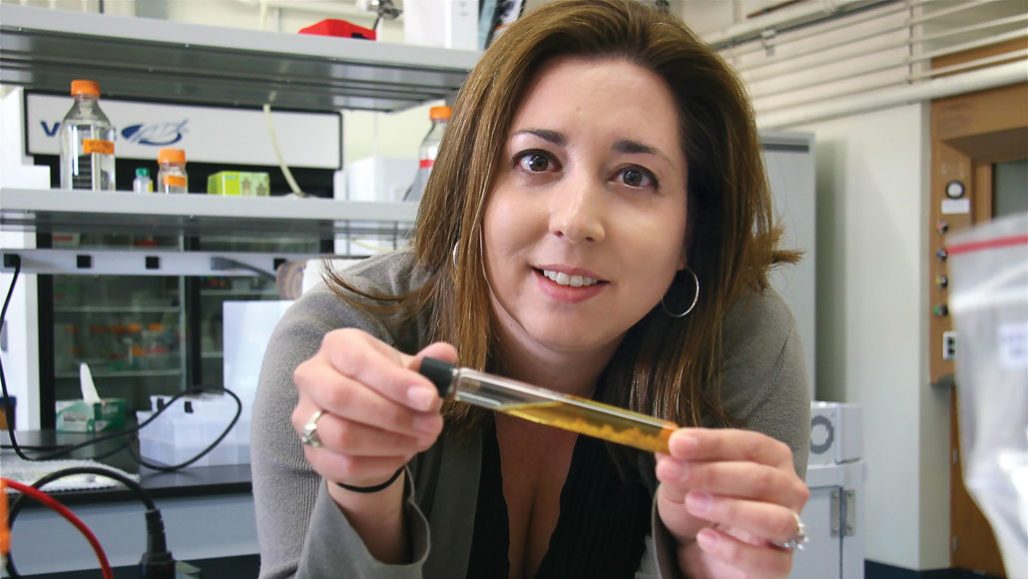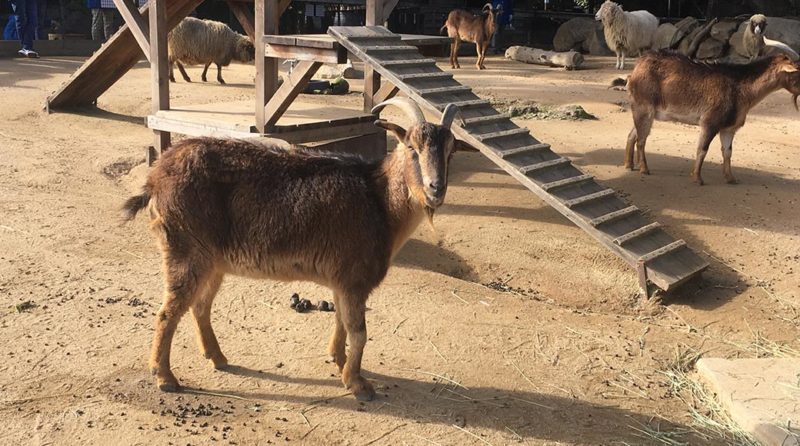Cool Job: One green chemist is mining zoo dung for biological helpers
Her goal is to convert farm-field wastes into useful fuels and chemicals

Michelle O’Malley, 37, is a chemical and biological engineer at the University of California, Santa Barbara. Her team is looking to mine microbes from animal wastes in a search for making “greener” products.
UC Santa Barbara
You might call this group of lab members a poop patrol. Sometimes, they hang out at the Santa Barbara Zoo waiting for certain goats and sheep to do their business. But they’re not there just as a cleanup crew. To them, these droppings are more than waste. They’re the source of microbes that might one day become the route to greener fuels and chemicals.
Michelle O’Malley, 37, leads this group. She’s a chemical and biological engineer at the University of California campus across town. Her team is hunting for fungi that live in the digestive tract of plant-eating animals, such as sheep, goats, cows, giraffes and elephants. As anaerobes (AN-uh-roabs), those fungi can only live in the absence of oxygen. Together with some anaerobic bacteria, these fungi can break down grass and other plants. Along the way, they release sugars and other nutrients.
These particular microbial helpers do not usually show up in the human gut. That’s why much of the fibrous parts of plants that we eat goes undigested. It passes through our guts, largely unaltered, exiting as wastes out the other end.
Here at the zoo, the researchers are focusing on San Clemente Island goats and Navajo-Churro sheep. “It can be hard to tell the difference between goat and sheep poop,” notes O’Malley. So it helps to “watch the donation take place.”

Once collected, their pellets go to the lab. There, team members coax out the fungi that enable these animals to digest certain plants.
O’Malley had to learn what she calls “very old-school technology” to grow the finicky fungi in her lab. Then she turned to tracking down the distinctive plant-degrading enzymes that these fungi make. Her big-picture plan is to help society move away from fossil fuels, such as petroleum. In their place, she hopes to find more sustainable ways to make chemicals and fuels. Her raw materials could be agricultural leftovers — such as corn stover and wheat straw, for example. In the past, such leftover plant materials have often been viewed as waste because people can’t eat them.
Fungi point to helpful enzymes
The fibrous parts of plants are made of lignocellulose (Lig-no-SEL-yu-loas). That chemical, in turn, is made from smaller compounds. Among them are two sugars: cellulose and hemicellulose. And those sugars are rich in carbon. Carbon is also a major ingredient in most fuels and many other chemicals and drugs.
O’Malley’s team would like to mine lignocellulose for its carbon. The problem is that the fibrous parts of plants also contain lignin. It’s a structural material that serves “to keep microbes and their enzymes out” of plant cell walls, O’Malley explains. So lignin makes it difficult to get to the sugars in lignocellulose.
Industrial chemists have found ways to chemically or physically remove lignin. But those processes often are costly, toxic and wasteful (as lignin itself contains valuable chemicals).
Some fungi have a better approach. And that’s what drew O’Malley’s attention to plant-eating animals and their poop. It turns out, O’Malley says, that certain anaerobic fungi found in the guts of these animals could give industry a greener way to break down cellulose, hemicellulose — and even lignin.
After a goat’s grassy lunch, certain anaerobic fungi burrow into the plant cell walls. There they release enzymes that break down lignocellulose — lignin and all. These challenging fungi have a 10-syllable name: Neocallimastigomycota.
O’Malley studied under chemical engineer Anne Robinson. That was back when she was in graduate school at Carnegie Mellon University in Pittsburgh, Pa. Robinson isn’t surprised her former student is working with such a challenging microbe. She recalls her student as being “very unafraid to tackle problems” and “able to recognize the interesting or unusual result.”
One fungus: Many, many digestive enzymes
After graduate school, O’Malley contacted scientists who had worked with anaerobic fungi. Most had abandoned those studies. The microbes just proved too difficult to work with. Then Michael Theodorou invited her to work with him. He had pioneered research on such microbes. Today he works at Harper Adams University in Newport, England. Back then, though, Theodorou was in Wales. And there he taught O’Malley how to isolate and grow these fungi.
Their challenge was feeding the fungi what they needed to grow, all the while keeping oxygen out.
Her team now begins with roll tubes. Think of them as 3-D petri dishes that can support growth across their inner walls, all in an oxygen-free environment. Carbon dioxide and a food source with digestive fluids are added to the closed tubes. Next, her team rolls the tubes to get an even coat on the internal walls. After adding a fungi-rich poop slurry, they roll the tubes again. If the process works, fungal colonies grow.
“All of this requires a lot of careful, coordinated, quick movements,” O’Malley says. It’s “a lost art.”
In her UC Santa Barbara lab, O’Malley has been isolating fungi from zoo samples and studying their enzymes. Until now, “nobody really knew their true power,” she says. Those fungi (with a mouthful of a name) turn out to have genes to make the largest number of biomass-degrading enzymes known. That’s something her team reported in Science three years ago.
The researchers have now partnered these anaerobic fungi with brewers’ yeast (Saccharomyces cerevisiae). That yeast is a mainstay of the biochemical industry.
O’Malley’s group showed that the fungi efficiently broke down lignocellulose in reed canary grass. That freed the sugars to be converted to other products by the yeast. O’Malley and colleagues shared their findings, last year, in Biotechnology and Bioengineering.
With the goal of unleashing these powers for the biotechnology industry, O’Malley and her group are exploring whether it makes sense to harvest the enzymes from the fungi. Maybe they should just insert fungal DNA into yeast and bacteria. That could turn them into enzyme-making machines.
Figuring out the ideal way to break down lignocellulose “has been a really [unsolveable] problem for a long time,” says Michael Betenbaugh. This biochemical engineer works at Johns Hopkins University in Baltimore, Md. O’Malley “kind of forged out on her own,” he says. Her trick, he adds, was “looking for these unusual microbes that have been doing [it] for millennia.”







